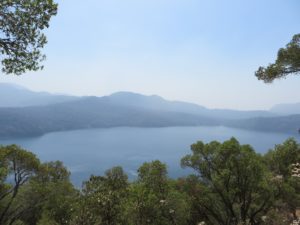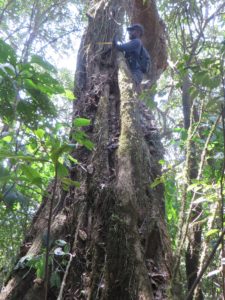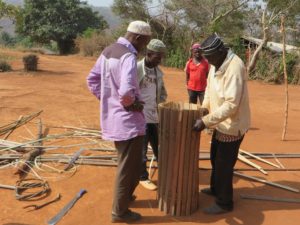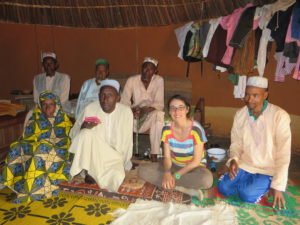By Dr Aida Cuni-Sanchez —
I was recently in the Cameroon Highlands to collect data on the socio-ecological functioning of mountain ecosystems, for the AFRISKYFOR project, funded by EU. The Cameroon Highlands contain tropical montane forests internationally renowned for their rich flora and high levels of endemism, combined with high degrees of threats (e.g. overhunting, illegal timber collection, and wildfire). The AFRISKYFOR project aims to assess the ecosystem services provided by montane forests, the threats to these forests, and potential management interventions – one of the study areas is western Cameroon.

Mt Oku Lake and Forest
During this field campaign, I worked with Mr Senghor (University of Dchang) and studied two montane forests in Mt Oku (also known as Kilum-Ijim) and Mt Mbam. Both forests are important habitats for several endangered species, such as the Bannerman’s Turaco (a colourful bird, Tauraco bannermani), the Oku sardine (a rodent, Lamottemys okuensis) and the Lake Oku Clawed Frog (Xenopus longipes).
The research team started with the social aspect of the study: discussing with village elders about the value and use of their forests. We worked with farmers and pastoralists from three different ethnic groups (Oku, Banso and Fulani). In this area, farmers mainly grow maize, beans and Irish potatoes; pastoralists own cattle and goats. These forests are very important to local communities. For example, forests provide firewood, building construction materials, medicine, wild fruits, honey and grazing grounds for livestock of pastoralists. White honey, made from Nuxia congesta flowers, is an important source of income, especially for the Oku people. Apart from forest benefits, we discussed threats to the forests, climate change (such as reduced rainfall), and potential management interventions. The most pressing threats identified are bush fires and the increasing number of goats which now graze inside the forest during the dry season, destroying tree’s seedlings. All villages were highly welcoming to the team, who was asked to provide ideas from other montane forests they had studied. Participants were particularly interested in identifying other forest products which could be sustainably harvested, apart from the white honey.

Mr Senghor sampling trees in the forest
After our team completed the social assessment, we began ecological surveys sampling vegetation. To set a baseline for long-term monitoring, we established permanent plots and sampled the trees for diameter, tree height, species and harvesting practices. To conduct the surveys, we had to carry heavy packs up and down the steep, vegetated slopes. We spent several nights hosted by local inhabitants in their hunting camps. These nights were very cold and smoky, as locals keep the fire on the whole night. One of our team members suffered from an upset stomach and received a great remedy from local traditional medicine. It is always good to see that the plants you are studying, and have so many functions, are indeed, useful! As we walked through these mountains, local people were surprised to see us and were always keen to ask us many questions. In these drier montane forests, bush fires are a real problem: the fires are ignited by both hunters and pastoralists, to either hunt or promote the growth of fresh grass that is nutritious for livestock. Fire ignites the edge of the forest, and slowly, the forest becomes smaller and more fragmented. Several people were concerned about this and asked: ‘Will the forests disappear?’. These forests are community forests currently managed by local communities, with no external funding support.

Training on making bamboo hives
Towards the end of the field campaign, our team organized a short training on how to make bee-hives from bamboo or Raphia (a small palm tree). It was moving to see efforts of the farmers and pastoralists to work together, given the conflicts that sometimes occur between these groups, such as livestock raiding of crops.
Our team spent the last few days at the Herbarium of Limbe, to identify the samples collected. Hopefully, they will find new records for some of the endangered species of the Cameroon Highlands, as these forests are not very well-studied. Let’s see what the expert botanist says!

Dr Cuni-Sanchez talking to pastoralists inside their house
Dr Aida Cuni-Sanchez is an EU Marie-Curie Postdoctoral Fellow with Colorado State University (USA) and the University of York (UK).
AFRISKYFOR has received funding from the European Union’s Horizon 2020 research and innovation programme under grant agreement No 743569.

